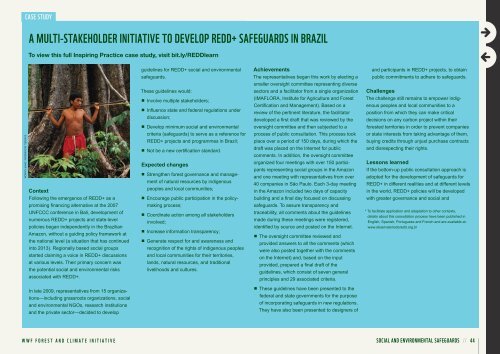WWF Guide to Building REDD+ Strategies
WWF Guide to Building REDD+ Strategies
WWF Guide to Building REDD+ Strategies
Create successful ePaper yourself
Turn your PDF publications into a flip-book with our unique Google optimized e-Paper software.
CaSe Study<br />
© NIGEL DICKINSON / <strong>WWF</strong>-CANON<br />
a multi-StakeHoldeR initiative <strong>to</strong> develoP Redd+ SaFeGuaRdS in BRazil<br />
To view this full Inspiring Practice case study, visit bit.ly/REDDlearn<br />
Context<br />
Following the emergence of <strong>REDD+</strong> as a<br />
promising financing alternative at the 2007<br />
UNFCCC conference in Bali, development of<br />
numerous <strong>REDD+</strong> projects and state-level<br />
policies began independently in the Brazilian<br />
Amazon, without a guiding policy framework at<br />
the national level (a situation that has continued<br />
in<strong>to</strong> 2013). Regionally based social groups<br />
started claiming a voice in <strong>REDD+</strong> discussions<br />
at various levels. Their primary concern was<br />
the potential social and environmental risks<br />
associated with <strong>REDD+</strong>.<br />
In late 2009, representatives from 15 organizations—including<br />
grassroots organizations, social<br />
and environmental NGOs, research institutions<br />
and the private sec<strong>to</strong>r—decided <strong>to</strong> develop<br />
guidelines for <strong>REDD+</strong> social and environmental<br />
safeguards.<br />
These guidelines would:<br />
n Involve multiple stakeholders;<br />
n Influence state and federal regulations under<br />
discussion;<br />
n Develop minimum social and environmental<br />
criteria (safeguards) <strong>to</strong> serve as a reference for<br />
<strong>REDD+</strong> projects and programmes in Brazil;<br />
n Not be a new certification standard.<br />
Expected changes<br />
n Strengthen forest governance and management<br />
of natural resources by indigenous<br />
peoples and local communities;<br />
n Encourage public participation in the policymaking<br />
process;<br />
n Coordinate action among all stakeholders<br />
involved;<br />
n Increase information transparency;<br />
n Generate respect for and awareness and<br />
recognition of the rights of indigenous peoples<br />
and local communities for their terri<strong>to</strong>ries,<br />
lands, natural resources, and traditional<br />
livelihoods and cultures.<br />
Achievements<br />
The representatives began this work by electing a<br />
smaller oversight committee representing diverse<br />
sec<strong>to</strong>rs and a facilita<strong>to</strong>r from a single organization<br />
(IMAFLORA, Institute for Agriculture and Forest<br />
Certification and Management). Based on a<br />
review of the pertinent literature, the facilita<strong>to</strong>r<br />
developed a first draft that was reviewed by the<br />
oversight committee and then subjected <strong>to</strong> a<br />
process of public consultation. This process <strong>to</strong>ok<br />
place over a period of 150 days, during which the<br />
draft was placed on the Internet for public<br />
comments. In addition, the oversight committee<br />
organized four meetings with over 150 participants<br />
representing social groups in the Amazon<br />
and one meeting with representatives from over<br />
40 companies in São Paulo. Each 3-day meeting<br />
in the Amazon included two days of capacity<br />
building and a final day focused on discussing<br />
safeguards. To assure transparency and<br />
traceability, all comments about the guidelines<br />
made during these meetings were registered,<br />
identified by source and posted on the Internet.<br />
n The oversight committee reviewed and<br />
provided answers <strong>to</strong> all the comments (which<br />
were also posted <strong>to</strong>gether with the comments<br />
on the Internet) and, based on the input<br />
provided, prepared a final draft of the<br />
guidelines, which consist of seven general<br />
principles and 29 associated criteria.<br />
n These guidelines have been presented <strong>to</strong> the<br />
federal and state governments for the purpose<br />
of incorporating safeguards in new regulations.<br />
They have also been presented <strong>to</strong> designers of<br />
and participants in <strong>REDD+</strong> projects, <strong>to</strong> obtain<br />
public commitments <strong>to</strong> adhere <strong>to</strong> safeguards.<br />
Challenges<br />
The challenge still remains <strong>to</strong> empower indigenous<br />
peoples and local communities <strong>to</strong> a<br />
position from which they can make critical<br />
decisions on any carbon project within their<br />
forested terri<strong>to</strong>ries in order <strong>to</strong> prevent companies<br />
or state interests from taking advantage of them,<br />
buying credits through unjust purchase contracts<br />
and disrespecting their rights.<br />
Lessons learned<br />
If the bot<strong>to</strong>m-up public consultation approach is<br />
adopted for the development of safeguards for<br />
<strong>REDD+</strong> in different realities and at different levels<br />
in the world, <strong>REDD+</strong> policies will be developed<br />
with greater governance and social and<br />
* To facilitate application and adaptation <strong>to</strong> other contexts,<br />
details about this consultation process have been published in<br />
English, Spanish, Portuguese and French and are available at:<br />
www.observa<strong>to</strong>riodoredd.org.br<br />
<strong>WWF</strong> FOREST AND CLIMATE INITIATIVE SoCial and enviRonmental SaFeGuaRdS // 44

















